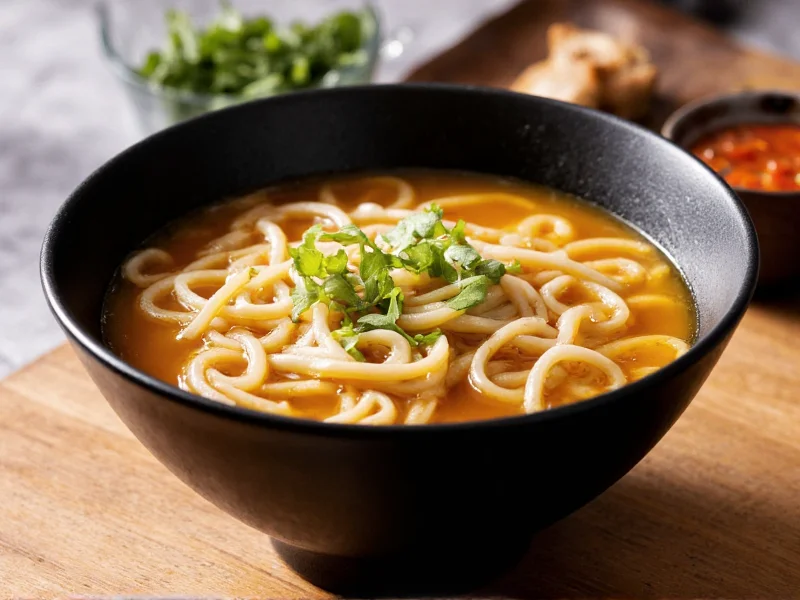For anyone exploring Japanese comfort food, miso udon soup represents a perfect harmony of texture and umami depth. This beloved dish transforms simple ingredients into a satisfying meal that's both nourishing and deeply flavorful. Understanding the proper technique and ingredient selection makes all the difference between an authentic experience and a disappointing imitation.
The Cultural Roots of Miso Udon Soup
While miso soup has been part of Japanese cuisine for centuries, the combination with udon noodles emerged as regional variations developed across Japan. Udon itself likely originated in China during the Nara period (710-794 CE), but evolved into its current thick, chewy form in Japan. The addition of miso to udon broth became particularly popular in colder regions where the fermented soybean paste provided both warmth and essential nutrients during winter months.
Unlike clear broth udon varieties, miso udon soup showcases regional diversity—Hokkaido's version often features corn and butter, while Nagoya's miso katsu udon incorporates their distinctive red miso. This regional variation demonstrates why understanding authentic miso udon soup preparation requires attention to both technique and cultural context.
Essential Ingredients Breakdown
The magic of miso udon soup lies in its component parts. Each ingredient serves a specific purpose in creating the complex flavor profile that defines this dish:
| Ingredient | Function | Recommended Type |
|---|---|---|
| Miso paste | Provides umami depth and saltiness | White (shiro) for mild flavor, red (aka) for robust taste |
| Dashi stock | Forms the flavor foundation | Kombu and bonito flakes for authentic preparation |
| Udon noodles | Creates satisfying texture | Fresh or frozen for best results; avoid dried for premium soup |
| Vegetables | Adds color, texture, nutrition | Spinach, mushrooms, green onions, carrots |
The Science Behind Perfect Miso Udon Broth
Creating exceptional miso udon soup requires understanding some basic food science principles. The temperature at which you add miso paste dramatically affects flavor development—adding miso to boiling broth destroys its delicate enzymes and subtle flavors. Professional chefs always temper miso by mixing it with a small amount of warm (not hot) broth before incorporating it into the main pot.
Different miso varieties contain varying levels of koji mold, salt content, and fermentation duration. White miso (shiro miso), fermented for 2-3 months, offers a milder, slightly sweet profile ideal for delicate broths. Red miso (aka miso), fermented 6-12 months, delivers a stronger, more complex umami punch perfect for heartier winter versions. Understanding these differences helps home cooks select the best miso paste for udon soup based on seasonal preferences and desired flavor intensity.
Step-by-Step Preparation Guide
Follow these professional techniques to create authentic miso udon soup from scratch:
- Prepare dashi properly: Simmer kombu in cold water for 30 minutes, then add bonito flakes. Remove from heat just before boiling to preserve delicate flavors.
- Cook udon noodles separately: Boil fresh udon for 1-2 minutes (frozen requires 8-10 minutes). Rinse under cold water to stop cooking and remove excess starch.
- Temper the miso: Whisk miso paste with 1 cup of warm dashi in a separate bowl until smooth before adding to the main broth.
- Add vegetables strategically: Hard vegetables like carrots should go in first, while delicate greens like spinach get added in the last minute.
- Never boil after adding miso: Keep broth at a gentle simmer (160-180°F) to preserve miso's enzymatic benefits and complex flavor compounds.
Variations and Customizations
While traditional miso udon soup follows specific preparation methods, several authentic variations exist across Japan. For those exploring vegan miso udon soup preparation, substitute bonito flakes with dried shiitake mushrooms and kombu for a rich, umami-packed dashi. The Nagoya-style version incorporates their distinctive hatcho miso for a deeper, earthier flavor profile.
Protein additions should complement rather than overwhelm the delicate broth. Traditional options include:
- Tofu (firm or silken)
- Thinly sliced pork belly (for miso nikomi udon)
- Tempura bits (agedama)
- Soft-boiled eggs
Nutritional Profile and Health Considerations
Miso udon soup offers notable health benefits when prepared traditionally. The fermented miso provides probiotics that support gut health, while the wheat-based udon noodles deliver sustained energy. A standard bowl (about 450g) contains approximately:
- 300-400 calories
- 15-20g protein
- 50-60g carbohydrates
- 5-8g fat
- Significant amounts of manganese, zinc, and vitamin K
For those monitoring sodium intake, remember that miso paste contains natural salt content. Using a lower-sodium miso variety and diluting with additional dashi can help reduce overall sodium while maintaining flavor complexity. The health benefits of miso udon soup extend beyond basic nutrition—studies suggest fermented soy products may support cardiovascular health and immune function.
Troubleshooting Common Issues
Even experienced cooks encounter challenges with miso udon soup preparation. Here's how to address frequent problems:
- Miso clumping: Always whisk miso with a small amount of warm broth before adding to the main pot
- Bland broth: Ensure proper dashi preparation; consider adding a small piece of kombu during simmering
- Mushy noodles: Cook udon separately and add just before serving
- Overly salty broth: Balance with a splash of rice vinegar or additional dashi
- Curdled miso: Never boil after adding miso; maintain gentle heat below 180°F
Serving Traditions and Pairings
In Japan, miso udon soup follows specific serving customs that enhance the dining experience. Traditionally presented in deep bowls to retain heat, the noodles should be arranged vertically with toppings placed thoughtfully on top. The proper sequence for eating involves first sipping the broth to appreciate its clarity and flavor, then mixing in the noodles and toppings.
For authentic Japanese comfort food miso udon experience, pair with:
- Steamed rice
- Simmered vegetables (nimono)
- Grilled fish
- Pickled vegetables (tsukemono)
Understanding these traditions transforms miso udon soup from a simple meal into a complete culinary experience that honors Japanese food culture.











 浙公网安备
33010002000092号
浙公网安备
33010002000092号 浙B2-20120091-4
浙B2-20120091-4